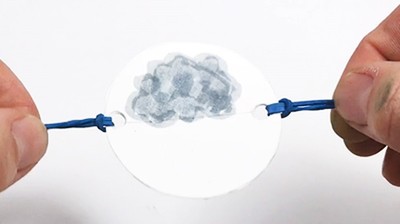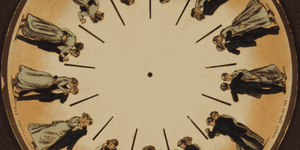Summary
Introduction
It's probably difficult to imagine a time with no television, no movies, and no cartoons. But believe it or not, those times weren't so long ago! What did those kids do when they couldn't watch movies? One of the most popular toys during that time was a great-grandfather of the modern cartoon. This toy was called a "thaumatrope," and in this activity you're going to make (and test) your own thaumatrope to learn about how vision works!
Materials
- White cardstock paper
- Grey and blue markers
- Clear tape
- Glue
- Scissors
- Ruler
- Pencil
- Compass
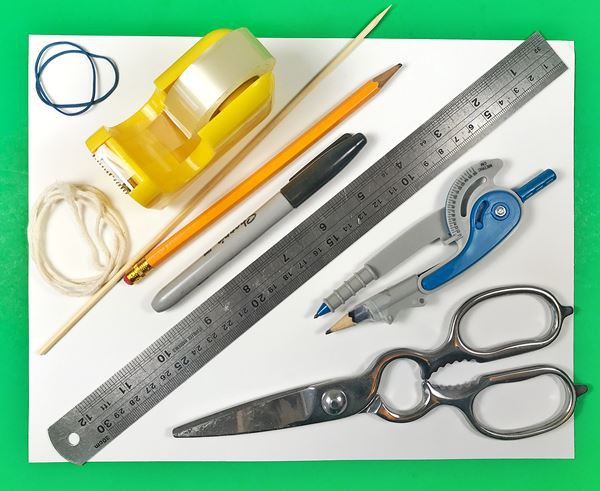 Image Credit: Svenja Lohner, Science Buddies / Science Buddies
Image Credit: Svenja Lohner, Science Buddies / Science Buddies
Prep Work
- Draw two circles on the cardstock paper, approximately two inches in diameter, and cut them out.
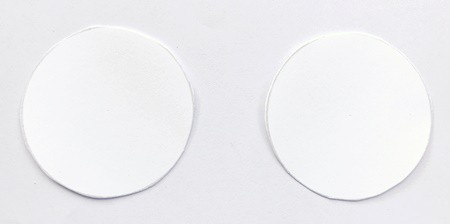 Image Credit: Svenja Lohner, Science Buddies / Science Buddies
Image Credit: Svenja Lohner, Science Buddies / Science Buddies
- Find the center of Circle 1 using your ruler. Use your pencil to lightly draw a line across the center.
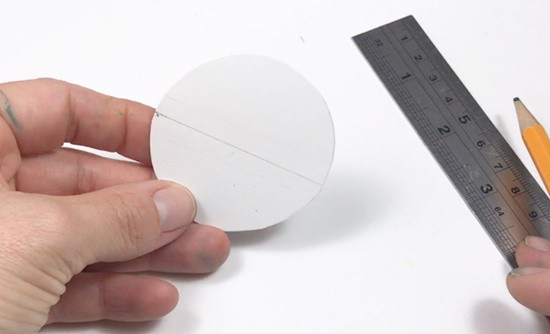 Image Credit: Svenja Lohner, Science Buddies / Science Buddies
Image Credit: Svenja Lohner, Science Buddies / Science Buddies
- On the upper half of the circle draw a grey cloud with your marker.
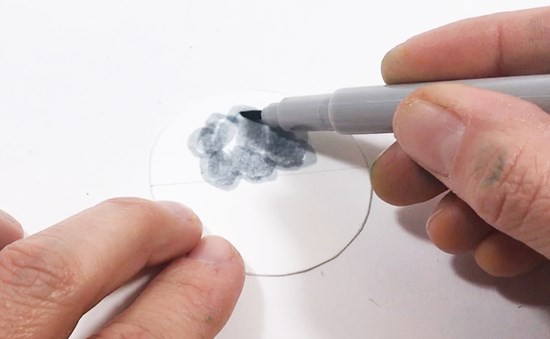 Image Credit: Svenja Lohner, Science Buddies / Science Buddies
Image Credit: Svenja Lohner, Science Buddies / Science Buddies
- Now begin with Circle 2. Draw a centerline across the middle of Circle 2.
- On the bottom half of the circle draw many little raindrops using the blue marker.
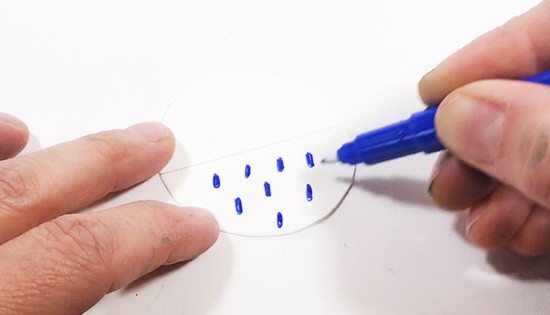 Image Credit: Svenja Lohner, Science Buddies / Science Buddies
Image Credit: Svenja Lohner, Science Buddies / Science Buddies
- Glue both circles together. Both centerlines of the circles should be aligned. Make sure to have both of the drawings on the upper side when turning the circle back and forth.
 Image Credit: Svenja Lohner, Science Buddies / Science Buddies
Image Credit: Svenja Lohner, Science Buddies / Science BuddiesThe left image shows one side of the paper circle with the grey cloud on the upper side of the circle. The right image shows the other side of the paper circle with the raindrops also on the upper side of the circle. The centerlines of both circles are aligned.
- Punch a hole on each side of the circle. Make the holes at each end of the centerline.
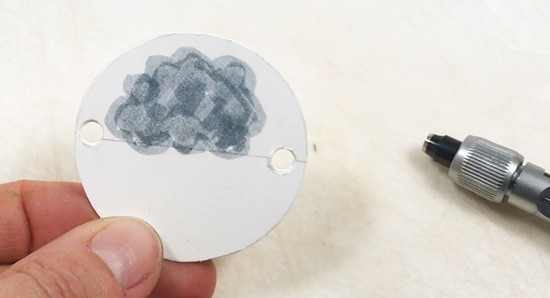 Image Credit: Svenja Lohner, Science Buddies / Science Buddies
Image Credit: Svenja Lohner, Science Buddies / Science Buddies
- Loop a rubber band through each of the holes and pull them tight.
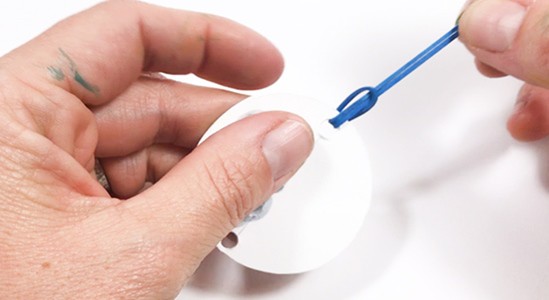 Image Credit: Svenja Lohner, Science Buddies / Science Buddies
Image Credit: Svenja Lohner, Science Buddies / Science Buddies
Instructions
- Hold the rubber bands between your thumbs and pointers.
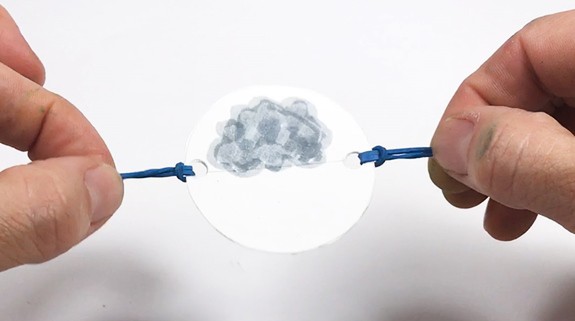 Image Credit: Svenja Lohner, Science Buddies / Science Buddies
Image Credit: Svenja Lohner, Science Buddies / Science Buddies
- Hum (or sing!) the ABC's song. Twist the rubber band between your thumb and pointer to the beat of the song while looking at the circles.What do you see as you look at the circles?
- Gradually increase the speed that you rotate the circles. Keep looking at them!What do you notice as the circles flip faster? Does anything change about how your drawings look?
- Rotate the circles as fast as you can while still looking at them.What do you notice about the drawings on the circle?
- Continue spinning the circles but try blinking every second.Does blinking your eyes change the way your drawings look? If so, what are the changes?
What Happened?
When you rotated the circles at top speed, the drawings on Circle 1 and Circle 2 should have merged together, so that you saw the raindrops falling from the cloud. Even though the cloud and the raindrops are on two different sides of your circle, when you spin them quickly, your brain doesn't process the two sides as separate images. Instead, it merges them together to create one drawing!
One reason our brains do this is to help us understand movement in the environment. When you watch a person walk across a room, you don't see every tiny movement that person makes as they walk. Instead, you see a continuous, smooth motion. If you have ever been in a room with a strobe light, you know how important it is that our brains can do this for us. A person dancing to a strobe light can look like a robot, because their movements seem disconnected and separate. Our brains can't connect the movements because the light is flashed only at relatively long intervals. You should have observed a similar effect when you watched the spinning circles while blinking. Even though you were spinning the circles at the same speed, your brain couldn't connect the images as it did when your eyes were open.
Digging Deeper
Thaumatropes employ the same science used by the artists that draw your favorite cartoons. While watching a movie, we see characters jumping, running and dancing instead of seeing hundreds of still images. Our brain takes the images flashing on the screen and connects them to form a continuous stream of motion. This is known as the illusion of apparent motion.
Thaumatropes use the same illusion to join two separate images into one image. They were one of the most popular toys available in the U.S. during the 1920s. Many of the original thaumatropes were made by gluing two pieces of paper together and spinning them on a string. In this activity you will make one yourself and bring two simple drawings to life!
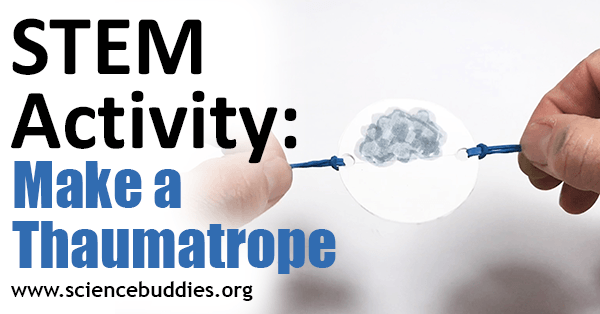 Image Credit: Science Buddies
Image Credit: Science Buddies
Ask an Expert
For Further Exploration
- Try drawing other things on the circles. For example, draw a fish on Circle 1 and a fishbowl on Circle 2. See what happens!
- Instead of using rubber bands and twisting them to spin the circle, you can also glue both of your circles to the top of a wooden skewer. Rub the skewer between your hands to make the circle spin. Do you get the same result with this method?

